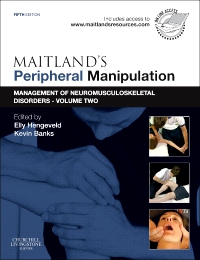
Maitland's Peripheral Manipulation, 5th Edition
Paperback

Now $110.50
The legacy of Geoff Maitland and his seminal work, Peripheral Manipulation, continues in this fifth edition, with Elly Hengeveld and Kevin Banks leading an international team of experts who demonstrate how to manage peripheral neuromusculoskeletal disorders using the principles and practice of the Maitland Concept. Together, they ensure the heart of the Concept beats on by promoting collaborative decision-making with the patient at centre and emphasizing the art and science of observation, listening, palpation and movement skills.
A key feature of the new edition focuses on a more evidence-based and analytical view of the role of mobilization and manipulation in clinical practice. The authors have written in a way that reflects their application of the Maitland Concept and how they have integrated techniques in the light of advancement in professional knowledge. Each chapter stands alone as a ‘master class’.
The text is systematically arranged focusing on detailed assessment, clinical reasoning and re-assessment to determine the physical dysfunction and efficacy of manipulative physiotherapy techniques, while also advocating continuous communication and interaction. Techniques of passive mobilization are also described, specifically designed around the individual patient’s condition.
All the chapters are written from a clinical perspective and review the evidence which informs how to deal with and manage peripheral joint pain as they present to the practitioner. Furthermore, each peripheral region (craniomandibular, upper limbs and lower limbs) is considered from the point of view of best practice in analysing and hypothesising subjective data, examination, treatment and management of peripheral pain conditions.
Brand new to the fifth edition is the addition of a companion website – Maitland’s Manipulation eResources (www.maitlandsresources.com) – providing access to a range of valuable learning materials which include videos, MCQs, interactive case studies, research links, and bonus chapters.
"Overall this text would be an excellent resource to any practising physiotherapist or health professional within musculoskeletal and orthopaedics from the new graduate to the experienced clinician." Tracy Ward, Senior Physiotherapist and Clinical Pilates Specialist, BMI Healthcare Albyn Hospital, Aberdeen, Oct 14
Newer Edition Available
-
- World-leading experts provide evidence relating the Maitland Concept to clinical practice
- Evidence supporting practice
- Covers both subjective and physical examination
- Best practice management using mobilization and manipulation
- Case studies – how and when to integrate the Maitland Concept into clinical practice
- Chapter-based learning outcomes, keywords and glossaries
- Companion website – Maitland’s Manipulation eResources (www.maitlandsresources.com)
-
1. The Maitland Concept as a clinical practice framework for neuromusculoskeletal disorders
Kevin Banks and Elly Hengeveld
2. The Maitland Concept: evidence-based practice and the movement sciences
Elly Hengeveld
3. Management of craniomandibular disorders
John Langendoen
4. Management of shoulder and shoulder girdle disorders
Phillip Ackerman and Matthew Newton
5. Management of elbow disorders
Toby Hall and Kim Robinson
6. Management of wrist and hand disorders
Pierre Jeangros
7. Management of hip disorders
Dianne Addison
8. Management of knee disorders
Gerti Bucher-Dollenz
9. Management of foot and ankle disorders
Jukka KangasAppendix
1. Self-management strategies: compliance and behavioural change
2. Recording


 as described in our
as described in our 